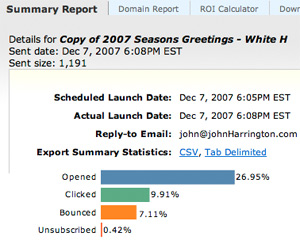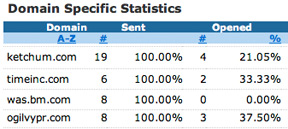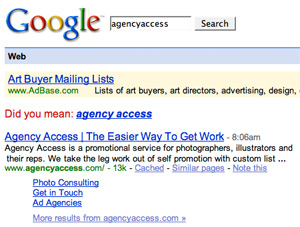Kenny Rogers Had A Point
 One of my daily reads is Rob Haggart's A Photo Editor. ( As an interesting aside, googling photo editor turns Rob up 5th. Not bad Rob!) One of the things that Rob wrote about today (Single Most Annoying Web 2.0 Feature for Photographers, 4/20/08) was that he was annoyed by those that are "Tracking my movements on your email promos and website."
One of my daily reads is Rob Haggart's A Photo Editor. ( As an interesting aside, googling photo editor turns Rob up 5th. Not bad Rob!) One of the things that Rob wrote about today (Single Most Annoying Web 2.0 Feature for Photographers, 4/20/08) was that he was annoyed by those that are "Tracking my movements on your email promos and website."
Rob then goes on to report on a photographer who...
(Continued after the Jump)
wrote to him and said “I see you’ve been checking out my book”. Rob then wrote "Then I realized they had tracked me from an email promo I clicked on and suddenly I felt duped."
As Kenny sings, in his song 'The Gambler', "you've got to know when to fold 'em, know when to show 'em, know when to walk away, and know when to run. You never count your money, when you're sittin' at the table..." and he has a point. What this photographer did was not only ensure that Rob won't book them, but by revealing he knew Rob had been there, he essentially killed his source. The way this photographer revealed this, was creepy.
Instead, the photographer should have either added Rob to a targeted e-mail list for future use, knowing that Rob was interested in him, or, if the photographer really wanted to call, he should have called and said "hey Rob, I wanted to call and follow up with you. I'd sent an e-mail with some images and my site link, and would love to continue to send those if they're of interest to you, and also, when there's a good fit, work with you on a project." And then shut up and say no more.
For those of you photo editors who think that clicking around a photographer's site, there's a little thing called Google Analytics, and this is how it looks on Rob's blog (under the hood):
<script src="http://www.google-analytics.com/urchin.js" type="text/javascript">So, whenever you come to his blog, he can track it, and rightfully so. There is a degree to which Google does not share information on that. In other words, Google is not revealing exactly who is coming to your site, but through some triangulation, they know the exact names (and a whole lot of other information) about who's going where.
</script>
<script type="text/javascript">
_uacct = "UA-2938384-1";
urchinTracker();
</script>
 For you photo editors who are getting e-mails from vendors, every e-mailer tracks clicks! At right is an example of a piece of a report I can get. I can drill down and see when you received the e-mail, when you opened it, if you loaded the graphics, and if you clicked through to my site. This is not unusual data mining.AgencyAccess, Adbase, and Vertical Response are among those that not only launch these campaigns for you (for pennies per-e-mail), but also track the effectiveness of each campaign, allow you to compare them to other campaigns, and so forth.
For you photo editors who are getting e-mails from vendors, every e-mailer tracks clicks! At right is an example of a piece of a report I can get. I can drill down and see when you received the e-mail, when you opened it, if you loaded the graphics, and if you clicked through to my site. This is not unusual data mining.AgencyAccess, Adbase, and Vertical Response are among those that not only launch these campaigns for you (for pennies per-e-mail), but also track the effectiveness of each campaign, allow you to compare them to other campaigns, and so forth.  Further, they maintain robust "opt out" options, so you will not only never get another e-mail from that photographer, but you can elect to never receive an e-mail again from any client of that list provider. Interestingly enough, a search for "agencyaccess", as noted above, shows adbase coming up in the paid listings above the search result that the searcher wanted, and I'd caution Adbase, as there are lawsuits ongoing now about the legality of doing this (Trademark lawsuit could put the squeeze on Google AdWords, 4/7/08)). But I digress....
Further, they maintain robust "opt out" options, so you will not only never get another e-mail from that photographer, but you can elect to never receive an e-mail again from any client of that list provider. Interestingly enough, a search for "agencyaccess", as noted above, shows adbase coming up in the paid listings above the search result that the searcher wanted, and I'd caution Adbase, as there are lawsuits ongoing now about the legality of doing this (Trademark lawsuit could put the squeeze on Google AdWords, 4/7/08)). But I digress....This ability to track and observe the surfing habits of site visitors is not only not new, but will get more and more invasive. Further, it is this ability to target, with laser-like precision, the interests of surfers, that will, while taking away our privacy, at the same time deliver us more of what we've demonstrated we're looking for. What do we want, spam for everything from medical offerings to watches, or just spam about photography? It's an interesting question.
Please post your comments by clicking the link below. If you've got questions, please pose them in our Photo Business Forum Flickr Group Discussion Threads.

3 comments:
Yup, That's how I figured out how to eliminate almost all spam. I noticed that the more I deleted, the more I got. Then I remembered a feature years ago on AOL mail that would notify you if the email was opened.
So I quit deleting them and just let them sit in the junkbox without letting the spammer know he has a live address. It took a couple months to slow down, then die off till I get 3-4, at most a day, sometimes none.
Also using Scriptblocker" addon in Firefox, I get to choose who gets to see me, and google analytics is never allowed. (Just because) he he
It's more work to surf, but I like the being in control thing.
Oh, and I use flashblock too, as malware can be delivered in flash now. (USA Today website was compromised last week).
Like the Firefox motto, "Take back control of the web"
arrpworks.blogspot.com
Ciao Y'all
The thing is, a good email campaign should link to well-designed landing page that let the recipient/visitor take action on the web.
In Rob's case, the photographer emailed directly after noticing he clicked a link. This shouldn't happen.
It's great to check your campaign reports and see who is doing what–but to actually follow-up with a specific recipient means you have way too much time on your hands. Dumb move.
In the odd case you still want to visit the site and avoid helping their ad directed (and tracked) url, I will usually just type in the direct url for the main site. That or search, this way I appear as just another visitor who came across the site and not a successful recipient of the mass-mailer.
Post a Comment